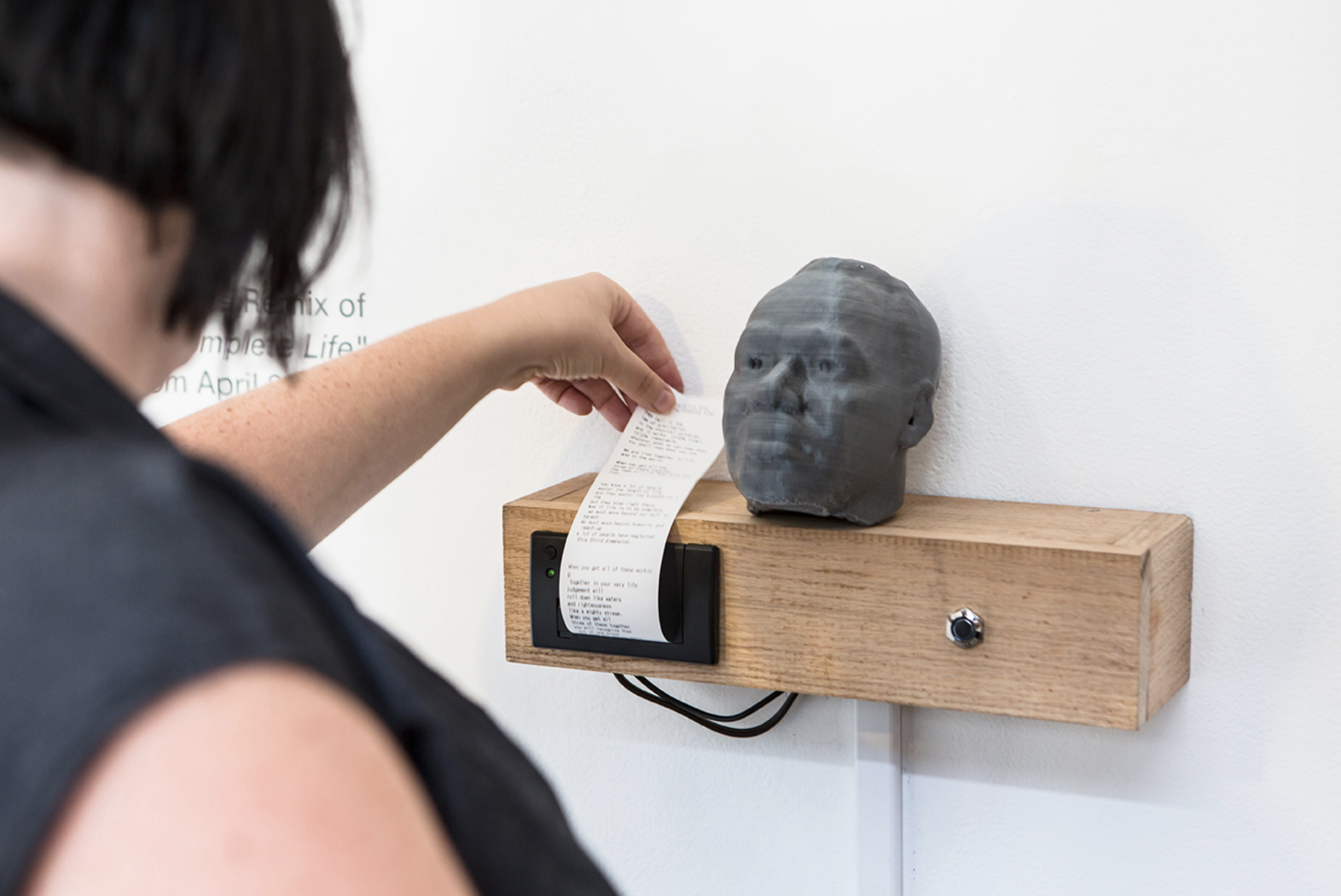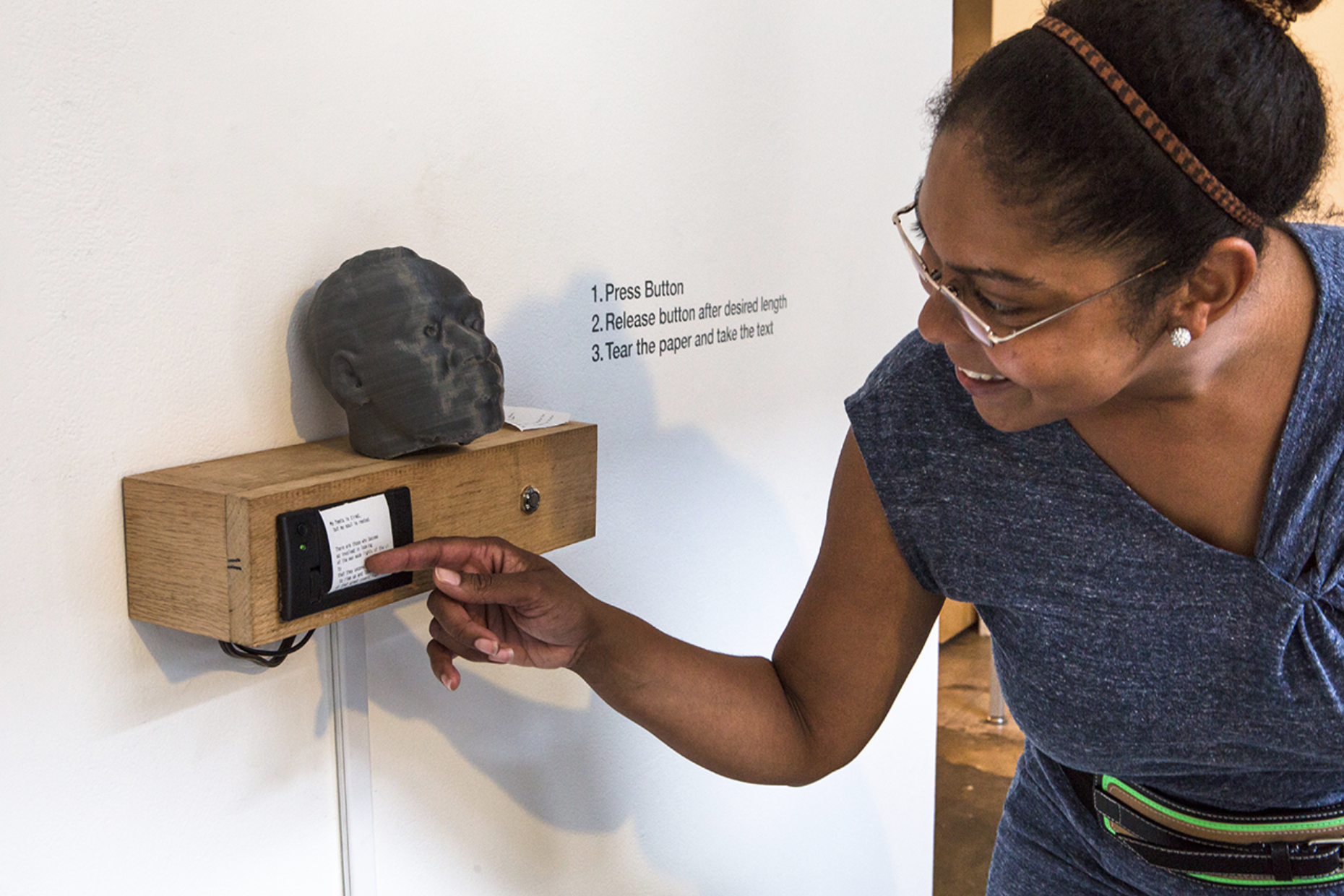“Random Access Remix of ‘The Three Dimension of a Complete Life’ by Martin Luther King, Jr.,” Billy Friebele, 3D PLA Print from 3D scan of a bust of Martin Luther King, Jr., arduino, thermal printer, hardwood, hardware, 2016.
The year 2020 made us breathless. It unexpectedly brought together a deadly respiratory pandemic with George Floyd’s plaintive cry, “I can’t breathe.” We are witnesses to an ongoing catastrophe in which more than 805,000 people have already lost their lives around the world, including more than 176,000 in the US, with a special concentration of loss in communities of color. We also witnessed worldwide protests against the murder of George Floyd and the many others who have lost their lives as a result of racist violence.
Now there’s a question everyone should be asking themselves. The pandemic continues to threaten the entire world but especially poor and minority communities. The protests, although they continue, have died down a bit. What will each of us do to help the world breathe? To end racism, to safeguard Black lives, and to create a lasting movement toward social justice? After all, Dr. Martin Luther King, Jr. himself believed that the fight against racism is inextricably connected to one for social justice.
Atlantika Collective was formed not only as a means to engage collaboratively with artists, writers, curators, educators and thinkers, but to take a stand on “social responsibility, community, and nurturing a contemporary humanism through art.” Of course, none of Atlantika’s members is laboring under the illusion that our contributions will in and of themselves turn the tide on racism or social justice. However, we do perceive that, if each and every one of us who cares about the future finds a way to make a meaningful contribution, the results can be transformative.
That’s why, in the weeks ahead, we’ll be sharing projects that Atlantika members have already created that focus on fighting racism or agitating for social justice. This new series, Social Justice, BLM, and Atlantika, is an effort to assert that these issues matter so much to our common future that they must continue to be a focal point for the foreseeable future, beyond the current round of protests and beyond the 2020 election. It signals a renewed commitment on the part of the entire Collective to make this subject a lasting focal point -- and to do our part to bring about a powerful worldwide movement for change.
In this first post, we explore the common ground between socially conscious works created by two Atlantika members whose work is often expressed through sculpture: Billy Friebele and Yam Chew Oh.
Artwork by Billy Friebele and Yam Chew Oh, text by Mark Isaac
When Atlantika members recently began to discuss racial and social justice as a group, we quickly found an unexpected harmony and dialogue between two sculptural works created by members Billy Friebele and Yam Chew Oh. Both works are focused on issues of racial harmony, both involve the use of sculptural busts, both are based heavily on a prominent written text, and both were created in 2016.
Billy Friebele’s piece, created during a residency at the Martin Luther King, Jr. Memorial Library in Washington, DC, in 2016 combines a 3D print of a bust of King with a machine that allows viewers to press a button and receive a printout of a random portion of his sermon, The Three Dimensions of a Complete Life, delivered at New Covenant Baptist Church, Chicago, Illinois, on April 9, 1967. In an interactive experience, viewers can tear off a random part of the speech and take it away with them as a reminder of what King had to say about creating balance in one’s life between self-interest, the welfare of others, and attention to the spiritual. In this speech, King eloquently suggests that a life lived only to advance the self is woefully incomplete, and that humans find their full expression only in reaching out to others and to God.



Installation views of “Random Access Remix of ‘The Three Dimension of a Complete Life’ by Martin Luther King, Jr.,” Billy Friebele, 3D PLA Print from 3D scan of a bust of Martin Luther King, Jr., arduino, thermal printer, hardwood, hardware, 2016.
Yam Chew Oh’s work is similarly based on a famous text -- in this case W.H. Auden’s poem titled, September 1, 1939, composed during the first few days of World War II. The poem was disavowed by Auden, who both altered and removed its most famous phrase, “We must love one another or die.” But it gained an ardent following despite Auden’s misgivings and has become a popular favorite, and one of the most famous poems dealing with the subject of war. It’s lasting impact was evident when it was often invoked in response to the attacks of September 11, 2001.
We must love each other or die, Yam Chew Oh, mixed media, 16 x 18 x 20 inches, 2016.
In Oh’s sculpture titled “We must love each other or die,” two busts, one black and one white, face each other from less than an inch apart. Placed on a common platform split in the middle, they resemble giant opposing chess pieces confronting each other with heads tilted back in an eternal standoff. And yet, linked with thin strings in a rainbow of hues that inextricably bind them together, they are also drawn to each other and appear on the brink of a kiss.
King’s 1967 sermon focuses extensively on the importance of providing aid and sustenance to others. “Somewhere along the way,” he admonishes, “we must learn that there is nothing greater than to do something for others.”
We must love each other or die (detail), Yam Chew Oh, mixed media, 16 x 18 x 20 inches, 2016.
Auden’s poem is mostly filled with a lament concerning the pathologies that have led to the advent of World War II, but it ends with a plea that he, among those who yearn for “the Just,” may fulfill some higher purpose:
May I, composed like them
Of Eros and of dust,
Beleaguered by the same
Negation and despair,
Show an affirming flame.
So both of the works by Friebele and Oh, finding inspiration in cultural masters, represent a calling to our higher selves. And in the context of current events, there can be no loftier aspiration than that of contributing to racial harmony and social justice. Although powerful forces relentlessly try to draw us away from this goal, we are only fully realized when we pursue it. And despite those who repeatedly try to draw us into conflict and separateness, we are only fully human when we embody love.

